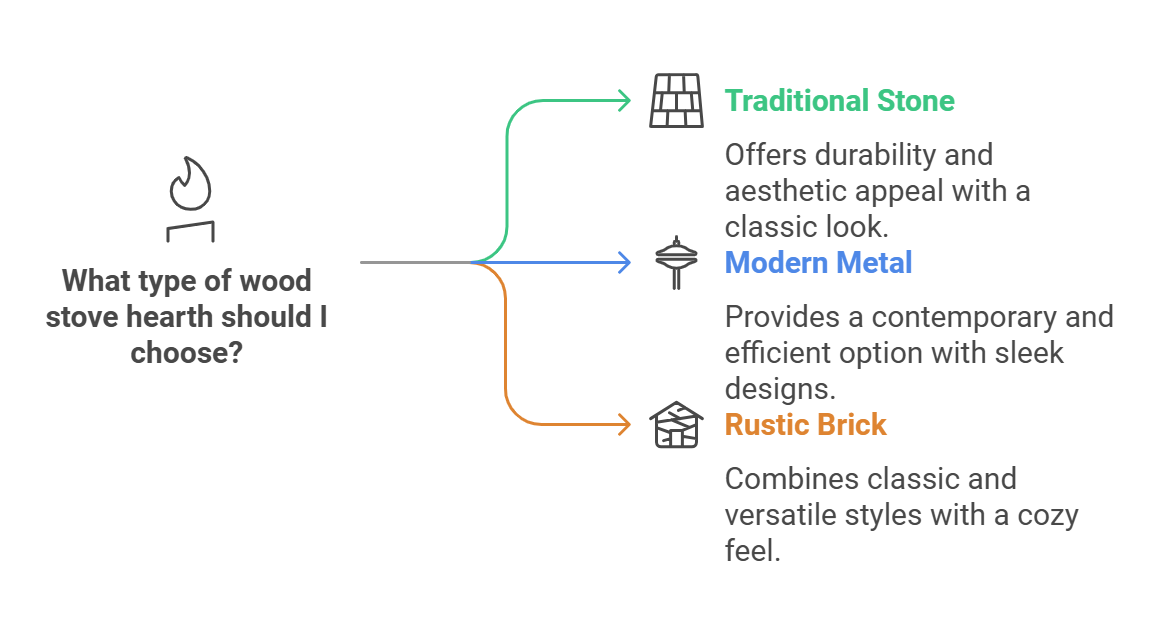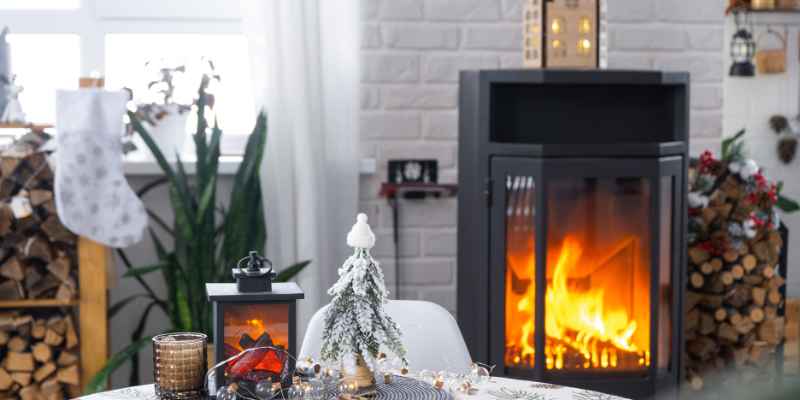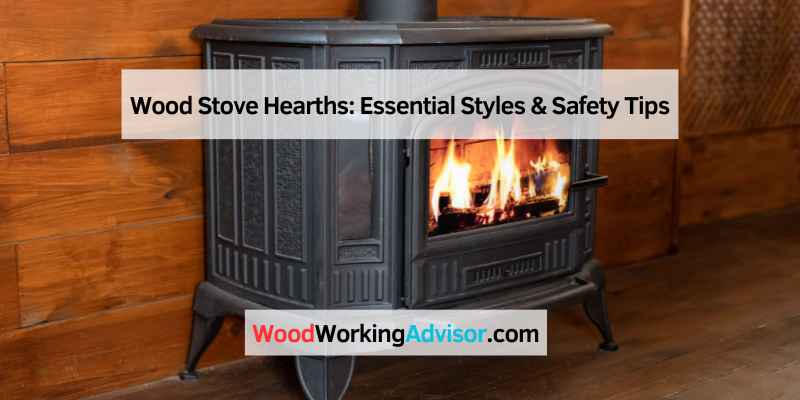Wood stove hearths provide a safe, heat-resistant base for wood stoves. They protect floors and enhance the stove’s aesthetic appeal.
A wood stove hearth serves both functional and decorative purposes in a home. It acts as a barrier against heat and sparks, safeguarding your flooring materials. Hearths come in various styles and materials, including stone, tile, and brick, allowing homeowners to match their decor.
A well-designed hearth can create a cozy atmosphere, making your living space more inviting. Proper installation is crucial for safety and efficiency, ensuring that the wood stove operates correctly. Understanding local building codes and safety regulations is essential for anyone considering a wood stove. Investing in a quality hearth enhances your home’s charm while providing safety and warmth.
Introduction To Wood Stove Hearths
Wood stove hearths are essential for safety and style. They protect floors from heat and embers. A well-designed hearth can enhance the overall look of your home. Understanding hearths helps in making informed choices for your space.
The Role Of A Hearth
The hearth serves several important functions:
- Fire Safety: It prevents fire hazards by containing sparks.
- Heat Protection: It shields flooring from heat damage.
- Aesthetics: It adds beauty to your wood stove.
- Functionality: It provides a stable surface for wood stoves.
Choosing the right hearth material is crucial. Options include stone, tile, and brick. Each material has unique benefits and styles.
Evolution Over Time
Hearths have changed significantly through the years. Here are some key developments:
| Era | Hearth Features |
|---|---|
| Medieval | Large, often central in homes for cooking and heating. |
| Victorian | Decorative styles emerged, focusing on elegance. |
| Modern | Minimalist designs with emphasis on safety and efficiency. |
Today, hearths combine safety with style. They reflect personal taste and home design.

Key Styles Of Wood Stove Hearths
Wood stove hearths come in various styles. Each style adds unique charm. Choosing the right one enhances your space. Here are some key styles to consider.
Traditional Stone Designs
Traditional stone designs offer a classic look. They bring warmth and elegance. Common materials include:
- Granite
- Slate
- Marble
These materials resist heat well. They create a sturdy base for your stove. Traditional stone hearths suit various home styles.
Modern Metal Options
Modern metal options bring a sleek, industrial vibe. They are often made from:
- Steel
- Aluminum
- Cast iron
Metal hearths are durable and easy to clean. They come in many colors and finishes. This style fits contemporary homes beautifully.
Rustic Brick Varieties
Rustic brick varieties offer a cozy, homey feel. They add a touch of nostalgia. Brick hearths are available in:
- Red brick
- Reclaimed brick
- Exposed brick
These options pair well with wood stoves. They provide good insulation. Rustic brick hearths work well in country or farmhouse styles.
Material Considerations
Choosing the right material for a wood stove hearth is crucial. The material affects durability, aesthetics, and safety. Different materials offer unique benefits. Here’s a closer look at popular options.
Stone: Durability And Aesthetics
Stone is a top choice for many homeowners. It provides excellent durability and can withstand high heat. Here are some key benefits:
- Heat Resistance: Stone can handle intense heat.
- Timeless Beauty: Natural stone adds elegance.
- Low Maintenance: Easy to clean and maintain.
Popular stone options include:
| Type of Stone | Characteristics |
|---|---|
| Granite | Strong, heat-resistant, and visually stunning. |
| Slate | Durable, non-porous, and available in various colors. |
| Limestone | Soft, easy to shape, but less heat resistant. |
Metal: Contemporary And Efficient
Metal hearths offer a modern touch. They heat up quickly and provide excellent efficiency. Key features include:
- Quick Heating: Metal absorbs and radiates heat fast.
- Lightweight: Easier to install compared to stone.
- Variety of Styles: Available in many finishes.
Common metal types are:
- Steel: Strong and durable.
- Cast Iron: Heavy, retains heat well.
- Aluminum: Lightweight, affordable option.
Brick And Tile: Classic And Versatile
Brick and tile offer a classic look. They provide good heat resistance and come in various designs. Benefits include:
- Traditional Appeal: Timeless and charming.
- Easy to Customize: Available in many colors and patterns.
- Fireproof: Safe for use around wood stoves.
Bricks and tiles can be arranged in countless patterns. This versatility allows for unique designs.
Size And Placement Strategies
Choosing the right size and placement for your wood stove hearth is crucial. Proper size ensures safety and efficiency. Smart placement enhances warmth and comfort in your home.
Determining The Right Size
The size of your wood stove hearth affects heat distribution and safety. Consider these factors:
- Stove Size: Match the hearth size to your stove.
- Room Size: Larger rooms need bigger hearths.
- Clearance Requirements: Follow manufacturer guidelines.
Use the following table to help determine the hearth size:
| Room Size (SQ FT) | Recommended Hearth Size (SQ FT) |
|---|---|
| 100-200 | 3-4 |
| 200-400 | 4-6 |
| 400-600 | 6-8 |
Ideal Placement In The Home
Placement of your wood stove hearth matters for comfort. Consider these tips:
- Center of the Room: Provides even heat distribution.
- Away from Walls: Keeps heat from damaging surfaces.
- Near a Chimney: Simplifies venting and installation.
- Accessible Area: Ensure easy access for wood storage.
Evaluate potential locations before making a decision. Test the layout with furniture to visualize space. Proper placement maximizes heat efficiency and safety.
Safety Tips For Wood Stove Hearths
Wood stoves provide warmth and comfort. Safety is crucial for preventing fires and accidents. Follow these tips for a safe wood stove experience.
Clearance Requirements
Keeping proper clearance around your wood stove is vital. This prevents heat damage and reduces fire risks. Follow these clearance guidelines:
- Maintain at least 36 inches of clearance from combustibles.
- Check local codes for specific requirements.
- Use non-combustible materials for hearth extensions.
Heat Resistance And Protection
Heat-resistant materials protect your home. They prevent heat from igniting nearby objects. Consider the following materials:
| Material | Heat Resistance |
|---|---|
| Brick | Excellent |
| Stone | Very Good |
| Tile | Good |
| Concrete | Good |
Use hearth pads to protect flooring. Ensure the stove sits on a fireproof base.
Routine Maintenance And Inspection
Regular maintenance keeps your stove safe and efficient. Schedule inspections at least once a year. Check these components:
- Chimney for creosote buildup.
- Gaskets for wear and tear.
- Flue pipes for rust or damage.
- Air vents for obstructions.
Clean your stove and chimney regularly. Follow the manufacturer’s instructions for maintenance.
Installation Best Practices
Installing a wood stove hearth requires attention to detail. Proper installation ensures safety and efficiency. Follow these best practices for a smooth setup.
Professional Vs. DIY Installation
Choosing between professional installation and DIY can be challenging. Here are the pros and cons:
| Method | Pros | Cons |
|---|---|---|
| Professional |
|
|
| DIY |
|
|
Tools And Materials Needed
Gather the right tools and materials before starting. Here’s a list to help you:
- Tools:
- Drill
- Screwdriver
- Level
- Measuring tape
- Hammer
- Materials:
- Hearth pad
- Wood stove
- Fireproof adhesive
- Sealing caulk
- Metal brackets (if needed)
Check local regulations before purchasing materials. This ensures compliance with safety standards.
Decorating Around Your Wood Stove Hearth
Creating a beautiful space around your wood stove hearth adds warmth and charm. The hearth can be a focal point in your home. Thoughtful decoration enhances its appeal. Here are some tips to make your hearth stand out.
Incorporating Into Your Home’s Theme
Align your hearth decorations with your home’s overall theme. Consider these styles:
- Rustic: Use natural wood and stone elements.
- Modern: Choose sleek lines and minimal decor.
- Traditional: Incorporate classic pieces and rich fabrics.
Use colors that complement your existing decor. Choose warm tones for a cozy feel. Bright colors can add a lively touch. Remember to balance the design with your room’s style.
Furniture And Decor Safety
Safety is crucial around your wood stove hearth. Follow these guidelines:
| Item | Safety Tips |
|---|---|
| Furniture | Keep flammable items at least 3 feet away. |
| Decor | Avoid using lightweight materials that can catch fire. |
| Rugs | Choose fire-resistant materials. |
Regularly check your decor for any wear or damage. Keep a fire extinguisher nearby. Ensure children know fire safety rules.
Common Questions And Solutions
Wood stove hearths often raise questions. Homeowners want to know about care, upgrades, and repairs. This section addresses common concerns and provides effective solutions.
Dealing With Cracks And Damage
Cracks can appear on wood stove hearths for several reasons. Changes in temperature and humidity can cause materials to expand and contract. Here are some effective solutions:
- Inspect Regularly: Check your hearth for cracks.
- Clean Thoroughly: Remove dirt and debris from cracks.
- Use Hearth Repair Kits: These kits fill cracks easily.
- Consider Professional Help: A professional can assess severe damage.
For small cracks, use a high-temperature sealant. This prevents further damage. Follow the manufacturer’s instructions for the best results.
| Crack Size | Recommended Action |
|---|---|
| Small (less than 1/8 inch) | Use sealant or repair kit |
| Medium (1/8 inch to 1/2 inch) | Fill with mortar or professional repair |
| Large (over 1/2 inch) | Call a professional for repair |
Upgrading An Old Hearth
Upgrading your old hearth enhances safety and aesthetics. Here are some popular options:
- Material Change: Switch from tile to stone or brick.
- Size Increase: Make the hearth larger for better protection.
- New Designs: Choose modern patterns or colors.
- Install Heat Shields: These protect the floor from heat damage.
Consider your home’s style. Choose materials that complement your decor. Measure your space before making any decisions. This ensures a perfect fit.

Frequently Asked Questions
What Is A Wood Stove Hearth?
A wood stove hearth is a non-combustible surface beneath and around the stove. It protects your flooring from heat and embers. Hearths are typically made from stone, tile, or brick. They also enhance the aesthetic appeal of your space while ensuring safety and compliance with building codes.
Why Do I Need A Hearth For My Stove?
A hearth is essential for safety and functionality. It prevents heat damage to floors and reduces fire risks. Many local building codes require a hearth for wood stoves. Additionally, it adds a decorative touch, making your living area more inviting and warm.
How To Choose The Right Hearth Material?
Choosing the right hearth material involves considering durability and aesthetics. Popular options include tile, stone, and brick. Each material offers unique benefits, such as heat resistance and easy maintenance. Ensure the material complements your home’s style while meeting safety standards for your wood stove.
Can I Install A Wood Stove Hearth Myself?
Yes, you can install a wood stove hearth yourself if you’re handy. However, it requires careful planning and adherence to safety codes. Ensure you use non-combustible materials and follow manufacturer guidelines. If unsure, consulting a professional installer is advisable for optimal safety and compliance.
Conclusion
Choosing the right wood stove hearth is essential for both safety and aesthetics. It enhances your home’s warmth and charm. Consider materials, design, and size to find the perfect fit. A well-crafted hearth not only protects your space but also adds character.
Invest wisely for a cozy, inviting atmosphere.

